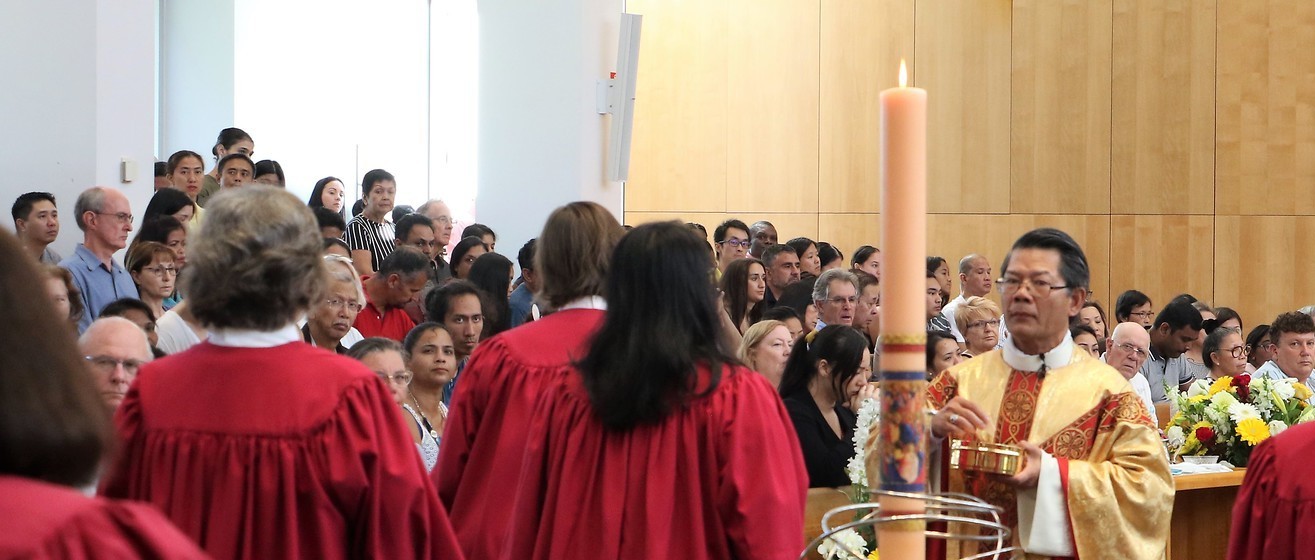The Breaking of the Bread and the Communion Procession
National Liturgical Council

The Breaking of the Bread
After the Greeting of Peace comes what is called the Fraction. This technical word ‘fraction’ means breaking. In this instance it refers to the Breaking of the Bread that has been consecrated as the Body of the Lord.
‘In apostolic times this gesture of Christ at the Last Supper gave the entire Eucharistic action its name. This rite is not simply functional, but it is a sign that in sharing in the one bread of life which is Christ we who are many are made one.’ (1 Cor 10:17,56)
It is very important that the whole assembly is able to see the Breaking of the Bread and there should be nothing happening that should distract people from viewing this action. If there are extraordinary ministers of the Eucharist who are to assist, they should have come forward to take their places at the end of the Greeting of Peace and before the Fraction Song begins.
The custom has been for many centuries to sing the Latin Agnus Dei (Lamb of God) during this action. This hymn derives from the Gospel according to John, when the Baptist saw Jesus and remarked ‘Here is the Lamb of God who takes away the sins of the world.’ (John 1:29)
There are occasions when the singing of the Lamb of God might need to be extended if the action of breaking and distributing into the vessels for communion is for a large assembly. If the communion is to be administered in both species this is also the time when the consecrated wine should be poured into the cups for distribution.
‘It is most desirable that the faithful, just as the priest himself is bound to do, receive the Lord’s Body from hosts consecrated at the same Mass and that, in the instances when it is permitted, they partake of the chalice, so that even by means of the signs Communion will stand out more clearly as a participation in the sacrifice actually being celebrated.’ (General Instruction of the Roman Missal 85)
The Communion Procession
The Catechism of the Catholic Church tells us ‘The Lord’s address and invitation to us, urges us to receive him in the sacrament of the Eucharist: Truly, I say to you, unless you eat the flesh of the Son of man and drink his blood, you have no life in you.’ (CCC 1384)
This invitation is responded to in the processional movement of the assembly to the table. In coming to the altar we are the visible members of Christ’s Body coming to be nourished by the sacrament of his Body and Blood.
It is desirable that during the Communion Procession the people sing a hymn or song that expresses the unity of all called to Christ’s banquet. From a musical point of view it is best to choose a hymn or song that has a refrain that all might memorise and sing during the procession with the choir or cantor singing the verses. The Eucharistic hymns or songs sung at this point should not be adorational in content, as these are better suited to Exposition or Benediction.
As the individual receives communion it is most important that we reply “Amen” to the minister’s words “The Body of Christ”, “The Blood of Christ.”
It is our affirmation that what we are receiving is indeed the presence of the living Christ in the sacramental form of bread and wine. The Communion Procession should only be for those members of the assembly who are receiving Holy Communion.
It is customary in many parishes to have a period of silence at the end of the Communion Procession. If a hymn or a song is sung at this point of the celebration it should be joyful in nature. The Communion Rite concludes with the prayer after communion.
‘To bring to completion the prayer of the People of God, and also to conclude the entire Communion Rite, the priest sings or says the Prayer after Communion, in which he prays for the fruits of the mystery just celebrated . . . and) the people make the prayer their own by the acclamation: Amen’. (GIRM 89)
This article was originally published in Let’s Walk Through The Mass. © Diocese of Parramatta. 1999, 2000, 2007. Reprinted with permission.
